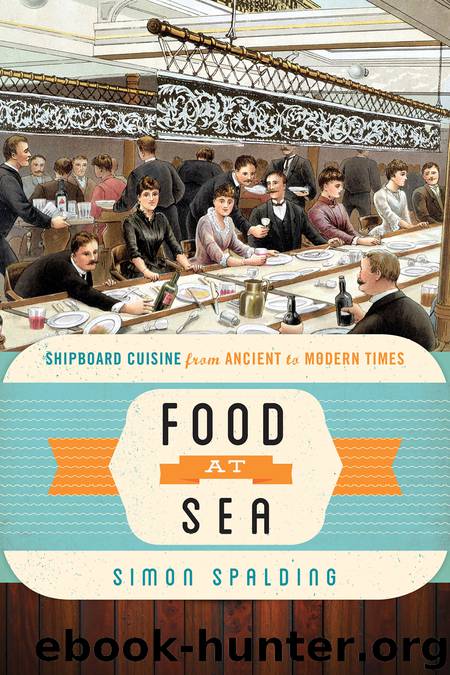Food at Sea by Simon Spalding

Author:Simon Spalding
Language: ara, eng, fra
Format: epub
Publisher: Rowman & Littlefield Publishers
Published: 2014-11-17T19:33:03+00:00
SIX
Steam Power and Canned Food
During the nineteenth century, the nature of sea travel was transformed by the application of steam power to oceanic travel. At roughly the same time, the development and application of canning changed the way people ate while traveling on the sea. Both processes were gradual and partial: the adoption of both steam power and canned food was accompanied by challenges and misadventures. In 1800, oceanic passenger travel was entirely powered by the wind; by the end of the century, passenger travel was almost entirely powered by steam. In 1800, the navies of the world were wooden-hulled, wind-powered, and carried their guns in long rows in broadside; by 1900, the world’s warships were steam-powered, steel-hulled, and carried their biggest guns in armored revolving turrets. During the same period, techniques of canning food made it possible to keep food for much longer periods. Both the introduction of steam power and the canning of food changed the way people ate at sea.
Steam Power Comes to the Oceans
The earliest steam-powered vessels were designed for protected waters. Paddle wheels quickly became established as the most convenient way to use steam power to propel a vessel through the water, and paddle steamboats proliferated in the bays, lakes, and rivers of the world during the first decades of the nineteenth century. It is not surprising that the adoption of steam power was more gradual for sea-going vessels than for those in protected waters. The keelboats and flatboats that preceded steamboats on rivers had great difficulties when navigating against the current. Sails could be useful if the wind was blowing in the right direction, but as there is limited maneuvering space on a river, the wind was only useful if astern to one’s direction of travel. Flatboats were navigated against the current by rowing, poling, and all too often “cordelling.” When cordelling a flatboat, the crew went ashore and pulled the boat upstream, like the mules on a towpath (but lacking a towpath along the banks of a river), marching or struggling along with a towrope or “cordelle.” It is hardly surprising that steam power, driving side- or stern-mounted revolving paddles, was quickly applied to river and inland water transport. In North America, most steam-powered riverboats were designed to use wood rather than coal for fuel. The hinterlands around the Mississippi, Missouri, and Ohio rivers have yet to recover from the deforestation of the nineteenth century, to fuel the steamboats that plied their waters.
The adoption of steam for oceanic travel took longer. The seagoing sailing vessel had been evolving for centuries, and wind power was harnessed efficiently by vessels in a wide range of sizes and designs. Early ocean-going steamboats used paddlewheels, which were easily damaged by powerful waves. The action of the waves could leave the paddles on one side or the other momentarily out of the water: it was customary to set a couple of sails on paddlewheel steamships just to stabilize the vessel, and thus to keep both paddlewheels in the water.
Download
This site does not store any files on its server. We only index and link to content provided by other sites. Please contact the content providers to delete copyright contents if any and email us, we'll remove relevant links or contents immediately.
The River by Peter Heller(2293)
Breath by James Nestor;(2265)
Sea Survival Handbook by Keith Colwell(2212)
Fatal Storm by Rob Mundle(2191)
Deep by James Nestor(2154)
Lonely Planet Australia by Lonely Planet(2052)
Iced In by Chris Turney(1979)
Discover Australia by Lonely Planet(1923)
Lonely Planet Maldives (Travel Guide) by Planet Lonely & Masters Tom(1817)
FOR THE LOVE OF THE SEA by Bohnet Jennifer(1757)
One Girl One Dream by Dekker Laura(1655)
Looking for a Ship by John McPhee(1651)
Ten Degrees of Reckoning: The True Story of a Family's Love and the Will to Survive by Hester Rumberg(1624)
Chicken Soup for the Ocean Lover's Soul by Jack Canfield(1620)
Lonely Planet Australia (Travel Guide) by Lonely Planet & Lonely Planet(1563)
South with the Sun by Lynne Cox(1558)
The Wave In Pursuit of the Rogues, Freaks and Giants of the Ocean(1522)
Diver Down by Michael Ange(1484)
Marlinspike Sailor's Arts and Crafts by Barbara Merry(1465)
